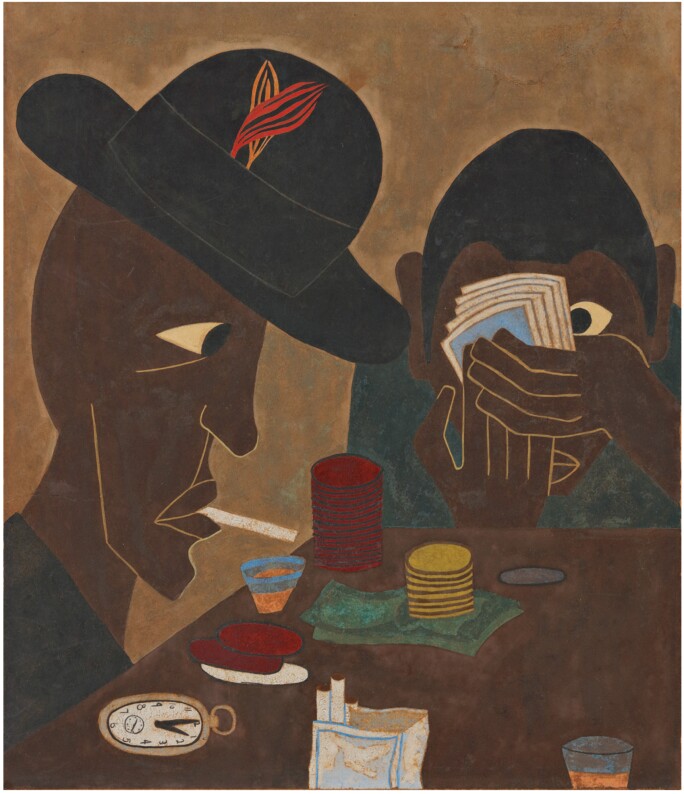Jacob Lawrence
Jacob Lawrence was a premier artist of the Harlem Renaissance; his work, including The Migration Series, led him to be the first African-American artist to join New York's commercial gallery roster. Today, Lawrence's work is included in a number of permanent collections, including those of the Metropolitan Museum of Art, New York; the Museum of Modern Art, New York; the National Gallery of Art, Washington, D.C.; and the J. Paul Getty Museum, Los Angeles.
Lawrence was born in 1917 in Atlantic City, New Jersey. After spending several years of his childhood in foster care, he and his siblings moved with his mother to Harlem. There, Lawrence began to experiment with art and found employment in a local workshop. He honed his craft over time, all while continuing to work odd jobs to support himself and his family. In 1941, Lawrence exhibited The Migration Series to much acclaim. The exhibition established Lawrence's place in Harlem's art scene, setting him up for even greater success following a period of military service during WWII.
In 1946, Lawrence began teaching with the Black Mountain College and was awarded a Guggenheim Foundation grant to complete The War Series. In the decades to follow, Lawrence's legacy grew along with his oeuvre of social realist works. Upon his death in 2000, the New York Times hailed Lawrence as "among the most impassioned visual chroniclers of the African-American experience."
William H. Johnson
Considered one of the country's foremost African-American artists, William H. Johnson's experimented with realism and expressionism before landing on a signature folk style, influenced by his experiences in Scandinavia. Johnson was born in Florence, South Carolina in 1901; at 17, he moved to New York City and worked until he could afford to attend classes at the National Academy of Design. In 1927, Johnson moved to Paris to continue his work and art studies. While there, he met the Danish artist Holcha Krake. The couple married in 1930 and lived in Scandinavia until 1938, when the tide of Nazi sentiments forced them to return to the United States.

Back stateside, Johnson worked as a teacher at the Harlem Community Art Center and became immersed in the burgeoning Harlem arts scene. During this period, Johnson painted scenes of both urban and rural African-American life, including Street life, Harlem (circa 1939-1940), Sowing (circa 1940) and others. Johnson painted the present work, Untitled (Uninhabited War Scene), during this period. On the verso is study of a woman in watercolor and gouache.
But while Johnson gained moderate artistic success from the 1940-50s, a series of hardships cut his tenure short. In 1944, his wife died from breast cancer, and in 1947, he was diagnosed with mental and motor impairment due to an infection of syphilis. He entered Center Islip State Hospital on Long Island to receive treatment for syphilis-induced paresis, where he remained until his death in 1970.
Despite this, Johnson's artistic legacy was preserved thanks to the Harmon Foundation, which gained rights to his work following his hospitalization. The foundation subsequently gave the work to the Smithsonian American Art Museum in 1967; since then, the museum has worked to expand the public's access and understanding of the artist.
In 2012, Johnson's art work gained a high American honor: the U.S. Postal Service issued a stamp of the artist's painting entitled Flowers (circa 1939-4-).
Norman Wilfred Lewis
Born in Harlem in 1909, Norman W. Lewis became a key figure in New York City's downtown art scene, painting abstract expressionist-pieces which drew from imagery of African-American life in the city.
Lewis began his art career in 1930, after studying under the tutelage of sculptor Augusta Savage at Columbia University.Savage helped Lewis secure studio space at the Harlem Community Art Center, where he developed a figurative style of painting founded on social realism.
Over time, Lewis's work became increasingly abstract, and the subject matter became more politically-charged. Migrating Birds (1954) is an important example of Lewis’ mature style and earned him the Popular Prize from the Carnegie Museum in 1955.
The present work, entitled Red and Blue Cloud Like, is dated 11-20-60. This work was created three years prior to Lewis becoming a founding member of Spiral Group, an initiative focused on engaging African-American artists with issues of racial injustice through their work.
Lewis died unexpectedly in 1979 at the age of 70.
Henry Ossawa Tanner
Born in 1859 in Pittsburgh, Pennsylvania, Henry Ossawa Tanner became the first African-American artist to be recognized, internationally, for his work. Over his lifetime, he developed an oeuvre drawing from religious imagery and scenes of life in early 20th-century America. His most famous work, entitled The Banjo Lesson (1893), is considered a critical reinterpretation of the minstrel-type portrayal of African-Americans.
Tanner studied at the Pennsylvania Academy of the Fine Arts, where he was the sole African-American student. This experience endowed Tanner with important connections, especially to Ashcan School founder Robert Henri, and honed his skill for figurative-style painting.
Later, Tanner moved to Paris, France to study at the Académie Julian. In Paris, Tanner found a welcome reprieve from the racial injustices of American society. He lived the rest of his life in Paris, studying under renowned artists and establishing a reputation in his own right. In 1896, his work Lions' Den was accepted for inclusion in that year's Salon; the present work, Untitled (A Water Carrier) is dated from February of the following year. The work is signed H.O. Tanner, and bares the inscription "To Madesmoiselle K*** Ma****/Paris 1898".
In 1923, Tanner was appointed a Chevalier of the Legion of Honor—the highest honor from the French government—in celebration of his distinguished career. Tanner died 14 years later at the age of 77.






